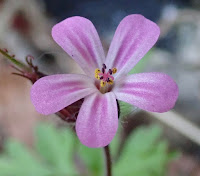30th June- 6th July 2-18
From previous blogs you might tell my two main interests are violets and yellow 'dandelions' so when I came across a slightly odd violet on the track from Puerto de San Gloria, see image below, I took a few photos. The attempted ID based, on the Alpine Flowers field guide suggested it could be Pyrenean Violet ( Viola pyrenaica ) . How wrong I was.
 |
| Track near Collado de la Guarde |
Like a Common Dog Violet with pointed sepals and a white spur, this violet lacked the slightly darker band at the limit of the white throat and overall petal colour was quite pale.
The veins are very clear and thin with some forking and extend just over half way suggesting V. canina ( Heath Dog Violet) however the leaves were rounded and definitely not V. canina. The sepal appendages were massive and this and the lack of the darker throat band suggested this was not a Common Dog Violet ( V. riviniana). The Alpine Flowers of Britain and Europe was consulted and Pyrenean Violet ( V. pyrenaica ) appeared to fit. The key feature to separate it from all the other violet species seems to be the heart shaped shiny-green leaves.
The leaves on this plant certainly had large, flat heart-shaped shiny green leaves. The leaves also seemed not to have any hairs or at least only a few short ones.
 |
| Bracteole high up on flowering stem and massive sepal appendages. |
One feature that does not quite fit, is the spur colour which was white maybe with slight yellow/green tinge. The Flora Europaea suggests this species should have a pale violet spur. The description in the Flora Europaea had a more serious problem in that the sepal is blunt in V. pyrenaica which puts this species into the Sweet/Hairy group rather than the Dog Violet group. The illustration in the Alpine Flowers book is misleading as it shows pointed sepals. More investigation using the internet shows the Flora Europaea to be correct. This plant is therefore not a V. pyrenaica. It does highlight the problem of using a single field guide to make an identification in difficult groups like violets. Also identification has to be based on the full range of features.
 |
| Dog Violet Sepal structure with backward appendage and pointed end. In our plant the sepal appendage was larger than normally found in Common Dog Violet. |
So where does this leave us. The backward pointing sepal appendages are too large for most Dog Violets. The leaves are unusual being as wide as they are long.
With a bit of help, another candidate was suggested, one I had not heard of before. Viola mirabilis.
Key features are:-
Leaves as long as wide, heart shaped, YES, margin crenate.
Spring leaves in basal rosette, in photos all stems seem to come from the base, so YES
Stems with a line of hairs, not observed or apparent on the photos taken. ?
Stipules. Photos not taken so don't know if conform. ?
Petals, pale violet, YES
Sepals acute and with conspicuous appendages, YES
Spur 6-8mm white. YES
This all looks good however , habitat is mainly in woodland, on base rich soils and they are not recorded in the Picos. nearest place recorded is Eastern Pyrenees. Looking at some of the better images of V. mirabilis on the internet, shows details like side petals having hairs in the throat very like the example and similar vein pattern , thin with limited splitting. One concern is that all the photos on the internet show the leaves having a pointed apex whereas the above photo shows a very blunted ended leaf shape. The other concern is that although the flower stems are not expected to have hairs, the leaves are often shown as having quite hairy stems and none of my photos show this.
Identification will have to remain uncertain but suggestions are welcome. This is a real puzzle as nothing quite fits.
Time to look at less difficult plants ?
Further down the track and off to the right near an outcrop of a pebble- based conglomerate rock I found a patch of a St. John's Wort. There are many species of St John's Wort.
The Petals.
The Sepals.
The sepals of the plant I found were marked with black streaks/dots all over -see photo above. The sepals of Imperforate St. John's Wort do not have black dots/streaks just occasional black glands. The plant I found had very pointed sepals and this is a feature of Alpine SJW.
Close up of leaf base also shows the stem is round. Imperforate SJW would have a square stem. Alpine has round stem so still looking good for Alpine. The base of the leaf also clasps the stem without any sign of a stalk and this is a good feature of the H. richeri subspecies. burseri which occurs in the Pyrenees and Picos.
Final close up shot of a unopened flower which shows the sepals with 'acute' pointed tips and cilate - ( regular arranged hairs projecting from the margin), hairs with black tipped glands. This fits the description of H. richeri subspecies. burseri in Flora Europaea. ID confirmed as Alpine St John's Wort subspecies burseri .
One Violet lost but one St John's Wort added to the species list.
Peter Leonard 31st August 2018























